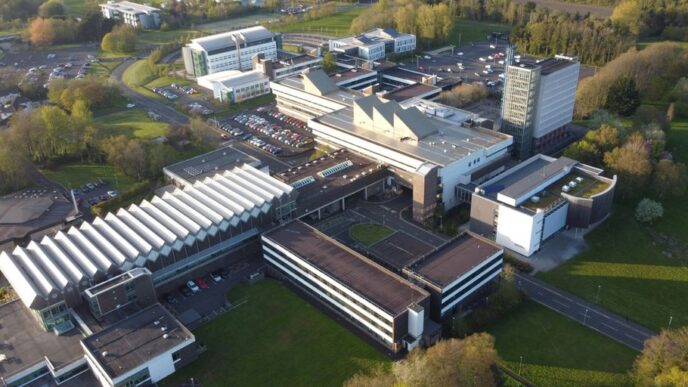Are you ready to enter a world where innovation knows no bounds? Where technology has the power to not only transform industries but revolutionize entire societies? In today’s fast-paced and ever-evolving landscape, disruption is no longer seen as a threat but rather an opportunity for growth. Join us on this thrilling journey as we explore “The Power of Disruption: Unleashing Innovation through Technology.” Prepare to be inspired, astonished, and perhaps even intimidated by the incredible potential that lies ahead. It’s time to buckle up and embrace the future – because it’s already knocking at our doors.
What Is Disruptive Technology?
Disruptive technology is any new technology that has the potential to significantly change the way we live or work. It can be something as small as a new app or as big as a new way of manufacturing products. Disruptive technologies often have a profound impact on the way we do business and can be the key to unlocking new and innovative ideas.
While there are many different types of disruptive technology, some of the most common include:
-3D printings
-Artificial intelligence
-Augmented reality
– Blockchain
– Electric vehicles
– Drone technology
– Virtual reality
Examples of Disruptive Technologies
In recent years, we’ve seen a surge in the adoption of disruptive technologies. Disruptive technologies are those that have the potential to change the way we live, work, and play. They are often game-changing innovations that create new markets and value networks.
Some examples of disruptive technologies include:
- Artificial intelligence (AI) and machine learning: AI is dramatically changing the landscape of many industries, from retail and transportation to healthcare and finance. Machine learning is a subset of AI that involves algorithms that can learn and improve on their own without human intervention.
- Electric vehicles: Electric vehicles are becoming increasingly popular as battery technology continues to improve. EVs offer a cleaner and more efficient alternative to traditional gas-powered cars.
- Blockchain: Blockchain is best known as the underlying technology behind cryptocurrencies like Bitcoin, but it has applications far beyond just digital currencies. Blockchain is a distributed database that can be used to record transactions and other data in a secure and tamper-proof way.
- Augmented reality (AR): AR is one of the hottest areas in tech right now, with companies like Apple, Google, and Facebook all investing heavily in this space. AR allows users to overlay digital information on top of the real world, creating new ways to interact with our surroundings.
Key Benefits of Disruptive Technology
As the world changes, so too must the way we do business. Disruptive technologies are those that have the potential to change the status quo and upend traditional businesses. Here are some of the key benefits of disruptive technology:
- Disruptive technologies can lead to new markets and new opportunities.
- Disruptive technologies can help you gain a competitive advantage.
- Disruptive technologies can improve your bottom line.
- Disruptive technologies can empower employees and customers alike.
- Disruptive technologies can help you tap into new markets and reach new customers.
Challenges of Adopting Disruptive Technology
Technology is rapidly evolving, and companies must adopt innovative technologies to remain competitive. However, adopting new technology can be challenging for companies. Employees may resist change, and new systems may not be compatible with existing ones. Additionally, disruptive technologies may require significant investment and may not yet be proven. Companies must carefully consider the risks and rewards of adopting new technologies to ensure that they are making the best decisions for their business.
How to Integrate New Disruptive Technologies into Your Business
In order to integrate new disruptive technologies into your business, it is first important to understand what these technologies are and how they can benefit your company. Disruptive technologies are those that have the potential to transform the way businesses operate and provide significant improvements in productivity, efficiency, and competitiveness.
Some examples of current disruptive technologies include artificial intelligence (AI), robotics, 3D printing, and virtual reality (VR). While many businesses are still hesitant to embrace these new technologies due to concerns about cost and complexity, there are a number of ways to successfully integrate them into your business.
One approach is to start small by piloting specific projects with a limited scope. This allows you to test the waters and see how the new technology can be used to improve your business without making a major investment. Once you have a better understanding of the potential benefits, you can then roll out the technology across your organization.
Another option is to partner with another company that is already using the technology in order to gain access to their expertise and resources. This can be an effective way to quickly get up-to-speed on the latest innovations without having to invest heavily in developing your own internal capabilities.
Ultimately, the key to successfully integrating new disruptive technologies into your business is to have a clear vision for how they can be used to create value for your company. By taking the time to assess the options and develop a plan for implementation, you can ensure that these powerful tools are used effectively to
Ways to Leverage the Power of Disruption
Innovation is born from disruption. By its very nature, innovation breaks the mold, shatters the status quo, and challenges the conventional wisdom. This is precisely why businesses must embrace disruption if they want to remain competitive.
There are a number of ways businesses can leverage the power of disruption. Perhaps the most obvious is to simply invest in disruptive technologies. This could mean anything from investing in cutting-edge software to developing new and innovative products or services.
Another way to leverage the power of disruption is to encourage a culture of innovation within your organization. Encourage employees to think outside the box and come up with new and creative ideas. Reward those who take risks and innovate. And make sure you have systems and processes in place to quickly turn good ideas into reality.
Don’t be afraid to disruptive yourself. Complacency is the enemy of innovation. Sometimes the best way to spur innovation is to shake things up a bit within your own organization. Embrace change, experiment, and always be on the lookout for better ways of doing things.
Conclusion
Disruption through technology has proven to be an immensely powerful tool for progress and innovation. Technology has provided us with ways to automate certain processes, open lines of communication between companies and customers that were previously impossible, and even revolutionize entire industries in just a few years. By leveraging the power of disruption, businesses will be better equipped to navigate challenges and capitalize on opportunities as the world continues to evolve. Innovative technology adoption is vital in today’s marketplace if businesses want to stay competitive yet successful amidst all the changes happening around them.











